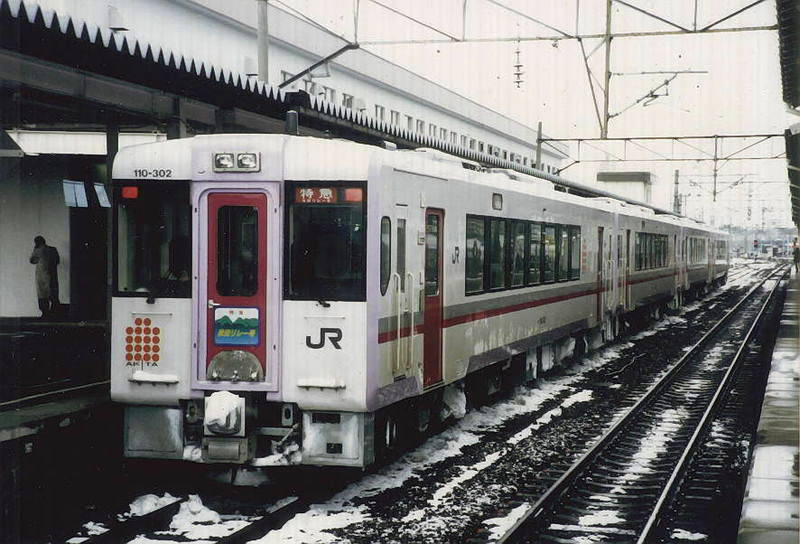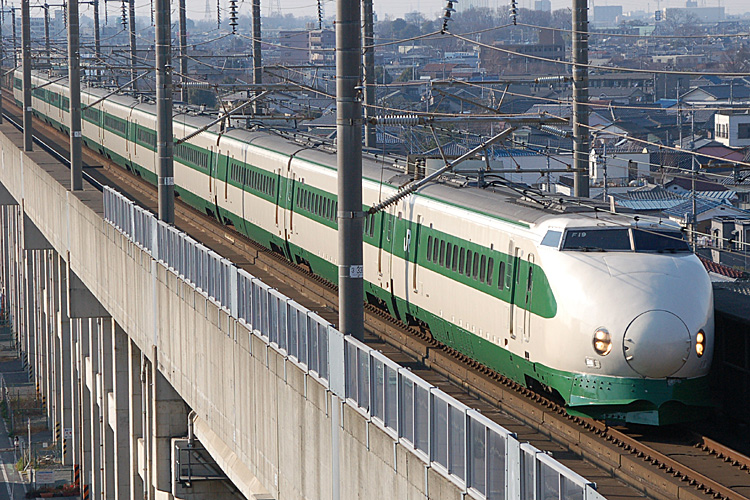|
Komachi (train)
The is a high-speed shinkansen service between and in Japan, operated by the East Japan Railway Company (JR East) since March 1997. It is the only shinkansen service that runs on the Akita Shinkansen, and uses E6 series trains. Between Tokyo Station and , it couples with Tōhoku Shinkansen E5 series ''Hayabusa'' and formerly E2 series for E3 series respectively. After Morioka, the ''Komachi'' service continues along standard gauge tracks that were converted from narrow gauge. Because it then runs on tracks that have grade crossings, its maximum speed from Morioka to Akita is , compared to on the Tohoku Shinkansen. The ''Komachi'' service was named after a famous poet from the area, Ono no Komachi, whose name (小町) is also synonymous with "belle" or "beauty" in Japanese. Station stops ''Komachi'' services stop at the following stations on the Akita Shinkansen between Morioka and Akita.JR Timetable, March 2013 issue For details of station stops between Tokyo and Morio ... [...More Info...] [...Related Items...] OR: [Wikipedia] [Google] [Baidu] |
Shinkansen
The , colloquially known in English as the bullet train, is a network of high-speed railway lines in Japan. Initially, it was built to connect distant Japanese regions with Tokyo, the capital, to aid economic growth and development. Beyond long-distance travel, some sections around the largest metropolitan areas are used as a commuter rail network. It is operated by five Japan Railways Group companies. Over the Shinkansen's 50-plus-year history, carrying over 10 billion passengers, there has been not a single passenger fatality or injury on board due to derailments or collisions. Starting with the Tokaido Shinkansen () in 1964, the network has expanded to currently consist of of lines with maximum speeds of , of Mini-Shinkansen lines with a maximum speed of , and of spur lines with Shinkansen services. The network presently links most major cities on the islands of Honshu and Kyushu, and Hakodate on northern island of Hokkaido, with an extension to Sapporo under constru ... [...More Info...] [...Related Items...] OR: [Wikipedia] [Google] [Baidu] |
Grade Crossings
A level crossing is an intersection where a railway line crosses a road, path, or (in rare situations) airport runway, at the same level, as opposed to the railway line crossing over or under using an overpass or tunnel. The term also applies when a light rail line with separate right-of-way or reserved track crosses a road in the same fashion. Other names include railway level crossing, railway crossing (chiefly international), grade crossing or railroad crossing (chiefly American), road through railroad, criss-cross, train crossing, and RXR (abbreviated). There are more than 100,000 level crossings in Europe and more than 200,000 in North America. History The history of level crossings depends on the location, but often early level crossings had a flagman in a nearby booth who would, on the approach of a train, wave a red flag or lantern to stop all traffic and clear the tracks. Gated crossings became commonplace in many areas, as they protected the railway from ... [...More Info...] [...Related Items...] OR: [Wikipedia] [Google] [Baidu] |
Railway Services Introduced In 1997
Rail transport (also known as train transport) is a means of transport that transfers passengers and goods on wheeled vehicles running on rails, which are incorporated in tracks. In contrast to road transport, where the vehicles run on a prepared flat surface, rail vehicles (rolling stock) are directionally guided by the tracks on which they run. Tracks usually consist of steel rails, installed on sleepers (ties) set in ballast, on which the rolling stock, usually fitted with metal wheels, moves. Other variations are also possible, such as "slab track", in which the rails are fastened to a concrete foundation resting on a prepared subsurface. Rolling stock in a rail transport system generally encounters lower frictional resistance than rubber-tyred road vehicles, so passenger and freight cars (carriages and wagons) can be coupled into longer trains. The operation is carried out by a railway company, providing transport between train stations or freight customer facili ... [...More Info...] [...Related Items...] OR: [Wikipedia] [Google] [Baidu] |
Passenger Trains Running At Least At 300 Km/h In Commercial Operations
A passenger (also abbreviated as pax) is a person who travels in a vehicle, but does not bear any responsibility for the tasks required for that vehicle to arrive at its destination or otherwise operate the vehicle, and is not a steward. The vehicles may be bicycles, buses, passenger trains, airliners, ships, ferryboats, and other methods of transportation. Crew members (if any), as well as the driver or pilot of the vehicle, are usually not considered to be passengers. For example, a flight attendant on an airline would not be considered a passenger while on duty and the same with those working in the kitchen or restaurant on board a ship as well as cleaning staff, but an employee riding in a company car being driven by another person would be considered a passenger, even if the car was being driven on company business. Railways In railway parlance, passenger, as well as being the end user of a service, is also a categorisation of the type of rolling stock used.Simmons, J ... [...More Info...] [...Related Items...] OR: [Wikipedia] [Google] [Baidu] |
Named Passenger Trains Of Japan
Named may refer to something that has been given a name. Named may also refer to: * named (computing), a widely used DNS server * Naming (parliamentary procedure) * The Named (band), an American industrial metal group In literature: * ''The Named'', a fantasy novel by Marianne Curley * The Named, a fictional race of prehistoric big cats, depicted in ''The Books of the Named'' series by Clare Bell See also * Name (other) * Names (other) Names are words or terms used for identification. Names may also refer to: * ''Names'' (EP), by Johnny Foreigner * ''Names'' (journal), an academic journal of onomastics * The Names (band), a Belgian post-punk band * ''The Names'' (novel), by ... * Naming (other) {{disambiguation ... [...More Info...] [...Related Items...] OR: [Wikipedia] [Google] [Baidu] |
List Of Named Passenger Trains Of Japan
This article contains lists of named passenger trains in Japan. Shinkansen (bullet trains) Daytime trains Limited express (partial list) Express Rapid Night trains Limited express Express Rapid See also * Rail transport in Japan References * JR Timetable, December 2008 * * {{reflist List of named passenger trains of Japan Japan Japan ( ja, 日本, or , and formally , ''Nihonkoku'') is an island country in East Asia. It is situated in the northwest Pacific Ocean, and is bordered on the west by the Sea of Japan, while extending from the Sea of Okhotsk in the north ... Named passenger trains ... [...More Info...] [...Related Items...] OR: [Wikipedia] [Google] [Baidu] |
Akita Relay
The was a limited express train service operated by East Japan Railway Company (JR East) in Japan between March 1996 and March 1997. Engineering work to convert the Tazawako Line between Morioka and Ōmagari from narrow gauge to standard gauge for use by Akita Shinkansen services entailed the complete closure of the line between March 1996 and March 1997. The ''Tazawa'' limited express services that previously linked Morioka with Akita and Aomori were curtailed to run between Akita and Aomori only, and temporary ''Akita Relay'' limited express diesel services were operated instead between Kitakami on the Tōhoku Shinkansen and Akita via the Kitakami Line and Ōu Main Line. Services commenced on 30 March 1996, with 10 "down" services and 11 "up" services operating daily using a specially built fleet of KiHa 110-300 series DMUs mostly in 4-car formations, but with some 3- or 7-car formations. These trains featured 2+2 abreast unidirectional limited express style seating ... [...More Info...] [...Related Items...] OR: [Wikipedia] [Google] [Baidu] |
Yamabiko (train)
The is a high-speed Shinkansen train service operated on the Tōhoku Shinkansen between and by East Japan Railway Company (JR East) in Japan. Name The word ''yamabiko'' is usually translated as 'echo', particularly one which is heard in the mountains. Rolling stock * E2 series (since March 1997) * E3 series (train), E3 series * E5 series (since November 2011) * E6 series (train), E6 series (since 16 March 2013)JR Timetable, March 2013 = * 200 Series Shinkansen, 200 series (June 1982 – November 2011) * E1 series (train), E1 series (''Max Yamabiko'') (July 1994 – December 1999) * E4 series (''Max Yamabiko'') (until 28 September 2012) issue * H5 series (since 26 March 2016) File:E2 J74 Yamabiko 216 Omiya 20110206.jpg, E2 series File:Shinkansen E3 komachi.JPG, E3 series File:JRE-TEC-E5 omiya.JPG, E5 series File:2013年1月20日E6系S12編成試運転.jpg, E6 series File:H5系 H1編成 仙台駅入線.JPG, H5 series Former rolling stock * 200 Series Shinkansen, 20 ... [...More Info...] [...Related Items...] OR: [Wikipedia] [Google] [Baidu] |
200 Series Shinkansen
The was a Shinkansen high-speed train type introduced by Japanese National Railways (JNR) for the Tohoku Shinkansen and Joetsu Shinkansen high-speed rail lines in Japan, and operated by East Japan Railway Company (JR East) until 2013. They actually predated the 100 series trains, having been built between 1980 and 1986. It was one of the two recipients of the 23rd Laurel Prize presented by the Japan Railfan Club, the first Shinkansen type to receive that award. The last remaining sets were retired from regular service in March 2013, and were completely withdrawn from service in April 2013. Design The 200 Series Shinkansen trains resembled the earlier 0 series trains in styling (some later units had the pointed 'shark nose' of the 100 series), but were lighter and more powerful, since these two lines are mountain routes and have steeper gradients. These lines are also prone to snowfall and the trains had small snowplows fitted, as well as protection of equipment against snow. ... [...More Info...] [...Related Items...] OR: [Wikipedia] [Google] [Baidu] |
Ono No Komachi
was a Japanese waka poet, one of the ''Rokkasen'' — the six best waka poets of the early Heian period. She was renowned for her unusual beauty, and ''Komachi'' is today a synonym for feminine beauty in Japan. She also counts among the Thirty-six Poetry Immortals. Life Almost nothing of Komachi's life is known for certain, save for the names of various men with whom she engaged in romantic affairs and whose poetry exchanges with her are preserved in the ''Kokin Wakashū''. She was probably born between 820 and 830, and she was most active in composing poetry around the middle of the ninth century. Extensive study has gone into trying to ascertain her place of birth, her family and so on, but without conclusive results. The Edo-period scholar Arai Hakuseki advanced the theory that there was more than one woman named Komachi and that the legends about her referred to different people. This theory was later expanded to conjecture that there were four "Komachis"., citing I ... [...More Info...] [...Related Items...] OR: [Wikipedia] [Google] [Baidu] |





